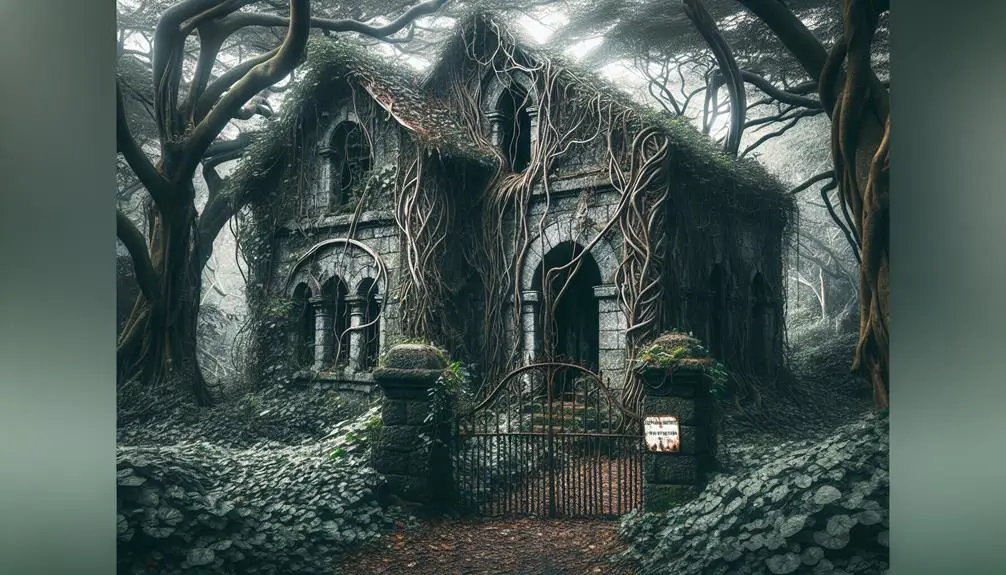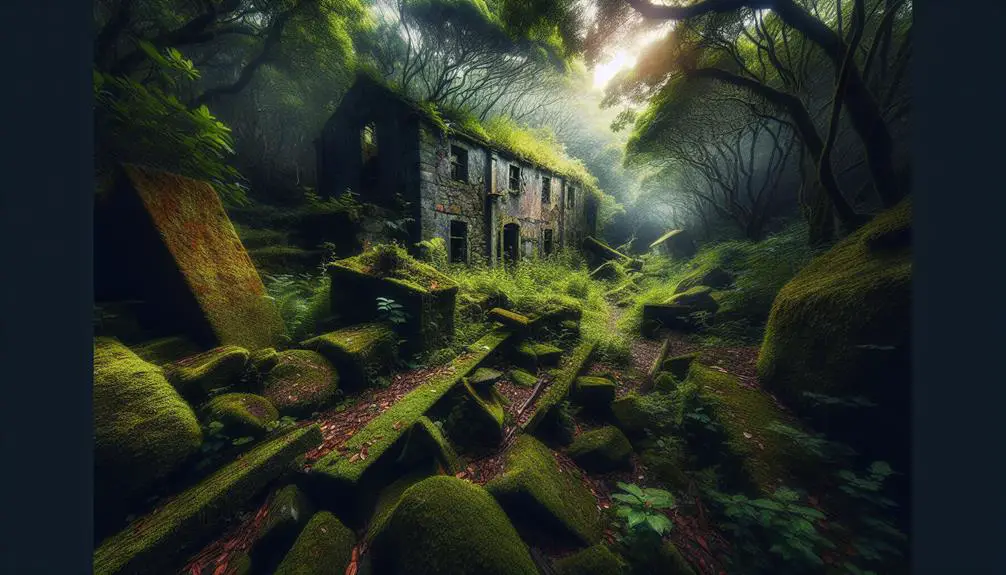To uncover historic colonial ghost town remnants, start with thorough research. Immerse yourself in local historical records for clues. Examine old maps, land deeds, census records, and newspapers. Investigate preservation efforts and restoration projects. Arrange findings and seek oral histories. Journey to visit museums, old cemeteries, and abandoned homesteads. Connect with local historians and participate in ghost town tours. Discover local legends and tap into oral traditions. Embrace respectful preservation practices to uphold heritage. By following these ten tips, you will set out on a quest to reveal the fascinating stories and secrets of colonial ghost towns.
Key Points
- Delve into local historical records to uncover information on colonial settlements.
- Explore old maps, land deeds, and census records for ghost town remnants.
- Engage with local historians and visit museums for in-depth insights.
- Investigate oral traditions and local legends for hidden lore.
- Respect and preserve heritage by maintaining structures and artifacts.
Research Local Historical Records
To explore uncovering the secrets of historic colonial ghost town remnants, start by delving into local historical records. Historical genealogy plays an important role in unraveling the past of these ghost towns. Begin your quest by examining old maps, land deeds, census records, and newspapers to trace the lineage of early settlers and understand how the town evolved over time.
Preservation efforts are often documented in these historical records. Look for information on any restoration projects, archaeological findings, or efforts to maintain the town's heritage. Understanding the steps taken to preserve the remnants of the ghost town can provide valuable insights into its history and significance.
Visit Local Museums and Archives
Explore a variety of local museums and archives to investigate further into the rich history of colonial ghost towns. Museums often house cultural artifacts that provide insights into the daily lives of past inhabitants. By examining these items up close, you can gain a deeper understanding of the customs and practices of colonial settlers. Additionally, historical archives within these institutions hold valuable documents and records that shed light on the economic, social, and political landscape of the ghost town's era.
Investigating local museums also offers the opportunity to delve into oral traditions and local legends surrounding the colonial ghost town. Through conversations with museum staff or guided tours, you may uncover fascinating stories passed down through generations. These tales can provide a unique perspective on the community's beliefs, values, and significant events that shaped its history.
Make sure to inquire about any special exhibits or events related to colonial ghost towns, as these can offer curated insights into specific aspects of life in these settlements. By immersing yourself in the curated displays and interactive experiences, you can enrich your understanding of the colonial era and its impact on the present day.
Explore Old Cemetery Grounds
Exploring old cemetery grounds provides a unique opportunity to uncover clues about the lives and histories of those who once inhabited colonial ghost towns. As you venture into these sacred spaces, consider the following:
- Graveyard exploration: Step beyond the well-trodden paths and into the forgotten corners; each tombstone holds a story waiting to be unearthed.
- Paranormal investigation: Feel the energy that lingers in the air, sparking your curiosity about the spirits that may still roam these grounds.
- Tombstone photography: Capture the intricate engravings and weathered stones, preserving the memory of those long gone.
- Historical research: Explore archives and historical records to piece together the narratives of the individuals laid to rest, connecting the past to the present.
Engage With Local Historians
Engage local historians to unravel the intricate tapestry of colonial ghost town narratives and gain invaluable insights into the lives of past inhabitants. Learning from these experts can greatly enhance your understanding of the historical context surrounding these abandoned settlements.
By connecting with local historians, you open up a world of knowledge that goes beyond what meets the eye in these ghost towns.
Local historians can provide you with a wealth of information about the people who once inhabited these places, their way of life, the events that shaped the community, and the reasons behind their eventual decline. Through engaging with them, you can discover fascinating stories and details that may not be found in mainstream historical accounts.
Attend Ghost Town Tours
Opt for guided ghost town tours to explore the rich history and eerie remnants of these abandoned settlements with expert commentary and insights. These tours offer you a unique opportunity to investigate the mysteries and stories that surround these ghostly towns.
- Feel the hair on the back of your neck stand up as you listen to chilling tales of ghostly encounters during the town's heyday.
- Experience a sense of thrill and anticipation as you initiate paranormal investigations in the abandoned buildings.
- Let your imagination run wild as you hear about supernatural sightings and haunted legends that still linger in the ghost town.
- Allow yourself to be transported back in time as you walk through the deserted streets, feeling the presence of the past whispering around you.
Search for Abandoned Homesteads
When exploring abandoned homesteads in historic colonial ghost towns, your first task is to carefully navigate the hidden ruins and document any architectural remnants you encounter.
Take note of the construction materials used, the layout of the buildings, and any unique features that might provide insight into the lives of the past inhabitants.
Explore Hidden Ruins
To reveal the secrets of bygone eras, explore the wilderness and search out the forgotten remnants of abandoned homesteads. Investigate the mysteries of these hidden ruins and discover the tales they've to tell.
Here are some tips to enrich your exploration:
- Listen attentively: The whispers of the past may guide your way.
- Immerse in the atmosphere: Let the spirits of the homesteads speak to you.
- Embrace the seclusion: Connect with the solitude of these abandoned places.
- Capture the essence: Preserve the essence of these spectral remnants in your memories.
Embark with an open mind and a keen eye, for within the ruins lie stories waiting to be uncovered.
Document Architectural Remnants
Investigating the remnants of deserted homesteads reveals a fascinating tapestry of architectural history waiting to be documented. To study ruins effectively, start by examining the structural integrity, noting any unique features or building techniques.
Take detailed notes on the materials used, construction methods, and overall layout. Photograph architecture from various angles to capture the essence of the homestead and preserve its memory.
Pay attention to any decorative elements, such as ornate window frames or intricate carvings, as they can offer clues to the time period and cultural influences. Documenting these architectural remnants not only helps preserve history but also allows for a deeper understanding of the lives and stories of those who once inhabited these now-abandoned spaces.
Study Old Maps and Documents
Examine carefully old maps and documents to uncover valuable insights into the history and layout of the colonial ghost town remnants. Map analysis can reveal the evolution of the town, showing expansions, changes in infrastructure, and potential areas of interest. Document study offers a glimpse into the lives of the town's inhabitants, their customs, and the events that shaped their community. By delving into the historical context surrounding these maps and documents, you can piece together a more thorough picture of the ghost town's past. Cartographic clues such as old roads, water sources, or property boundaries can provide vital information about the town's layout and function.
- Discovering an old map that showcases the town's original design can evoke a sense of nostalgia and wonder.
- Unraveling faded documents detailing the town's economic activities can spark curiosity about the people who once lived there.
- Piecing together fragments of maps to reconstruct the town's layout may bring a feeling of accomplishment and connection to the past.
- Finding handwritten notes on maps or documents can evoke a sense of intimacy with the town's former residents, offering a glimpse into their daily lives.
Document and Photograph Findings
Reviewing the discovered documents and photographs provides valuable insights into the historical context and visual representations of the colonial ghost town remnants. To capture and safeguard these findings effectively, start by organizing them chronologically or thematically. Carefully study each document for clues about the town's past inhabitants, activities, and structures. Analyze the photographs to identify architectural features, landscape changes, and social dynamics.
Look for details such as clothing styles, modes of transportation, or signs of economic prosperity or decline. Pay attention to the quality of preservation to determine the reliability of the information. Consider creating digital copies of the documents and photographs to guarantee their long-term accessibility and prevent further deterioration. Utilize image enhancement techniques to bring out hidden details and improve clarity. Compare different sources to cross-reference information and validate findings.
Seek Out Oral Histories
To uncover the secrets of historic colonial ghost towns, tap into local stories that have been passed down through generations.
By seeking out oral histories, you can unravel hidden lore and gain insights into the spectral encounters that have been recounted over time.
Exploring these narratives can provide a deeper understanding of the town's past and shed light on the mysteries that linger within its remnants.
Tap Into Local Stories
Uncover the rich tapestry of local stories by searching for oral histories to reveal invaluable insights into the historic colonial ghost town remnants. Immerse yourself in the past through the eyes and words of those who've lived near these mysterious ruins. By tapping into local stories, you can connect with the spirit of the land and the people who once walked its streets.
- Immerse yourself in the alluring local legends passed down through generations.
- Listen intently to chilling tales of ghostly encounters in the abandoned streets and buildings.
- Feel the weight of history in the whispers of those who remember the town's former glory.
- Let the echoes of the past guide you as you unravel the hidden secrets of these ghostly remnants.
Uncover Hidden Lore
Explore the concealed lore of historic colonial ghost town remnants by actively searching for oral histories that offer invaluable insights into the past inhabitants and the enigmas surrounding these deserted sites.
Unearthing secret legends and forgotten tales can provide a deeper understanding of the mysteries that shroud these ghost towns. Engaging with local communities or historians can reveal narratives passed down through generations, shedding light on the lives and events that once unfolded in these now abandoned places.
Explore Spectral Encounters
Uncovering the hidden lore of historic colonial ghost town remnants can pave the way for exploring spectral encounters through seeking out oral histories that hold the key to unraveling the mysteries surrounding these abandoned sites. When delving into the oral histories of ghost towns, you may encounter spirits that linger in the memories of the locals, shedding light on the past.
Investigating legends passed down through generations can provide insights into the spectral phenomena that are said to haunt these deserted areas. Listening to tales of paranormal activity from those who've experienced the unexplained firsthand can offer a glimpse into the eerie happenings that still resonate in these ghostly remnants. Remember, these oral histories aren't just stories; they're windows into a world where the past and present collide in haunting ways.
- Evoke fear: Share spine-chilling encounters with spirits.
- Stir curiosity: Unravel mysteries of spectral phenomena.
- Invoke wonder: Explore the depths of paranormal activity.
- Ignite passion: Investigate legends to uncover the truth behind ghostly tales.
Respect and Preserve Heritage
Preserving and respecting the heritage of historic colonial ghost town remnants is vital in maintaining their cultural significance and historical value. Preservation practices play an important role in safeguarding these sites for future generations. Implementing measures such as regular maintenance, conservation efforts, and controlled access can help prevent further deterioration of the structures and artifacts within these ghost towns. By respecting the cultural heritage embedded in these remnants, you contribute to the preservation of a tangible link to the past.
It is imperative to approach the preservation of these sites with care and sensitivity. Cultural heritage isn't just a thing of the past but a living representation of the people and events that shaped it. By understanding and valuing the significance of these remnants, you become a steward of history. Take the time to educate yourself on the historical background of the ghost town you're exploring, and consider how your actions today can impact its integrity for tomorrow. Embracing the responsibility of preserving these remnants ensures that their stories continue to be told and appreciated.
Frequently Asked Questions
Are There Any Specific Safety Precautions to Keep in Mind When Exploring Old Cemetery Grounds?
When exploring old cemetery grounds, remember proper graveyard etiquette. Respect the resting places of those who came before. Be cautious of unstable monuments and watch your step. Practice historic preservation by leaving everything as you found it.
How Can One Differentiate Between a Genuine Historic Site and a Modern Replica or Reconstruction?
To verify authenticity, assess architectural aspects. Authentic sites exhibit aged materials, intricate designs, and weathered structures. Compare historical documentation with modern features. Scrutinize craftsmanship, materials, and wear patterns for a genuine historical experience.
What Steps Can Be Taken to Ensure That Any Found Artifacts or Remnants Are Properly Preserved and Protected?
To guarantee proper preservation of found artifacts or remnants, engage in community discussions to determine conservation techniques. Incorporate preservation strategies while respecting cultural sensitivity. Communicate openly about protection measures for these historical treasures to foster a collaborative approach.
Are There Any Legal Restrictions or Regulations That Need to Be Considered When Documenting and Photographing Findings?
When documenting findings, legal considerations like property rights and cultural heritage laws are essential. Make sure you have permission to photograph artifacts, respecting privacy and intellectual property. Research local regulations to avoid legal issues and preserve history ethically.
How Can One Respectfully Engage With Local Communities and Descendants of the Colonial Era to Gain a Deeper Understanding of the History of Ghost Towns?
Engaging respectfully with local communities and descendants involves active listening, honoring oral histories, and valuing cultural sensitivity. Show genuine interest, offer to learn, and collaborate. Acknowledge the past and build relationships for a deeper understanding.



